Plants With Pink Flowers You Should Add to Your Garden
Since Valentine’s Day is around the corner, the color pink is on our minds. The pink color is associated with love, care, and kindness. As much as we deny, colors do impact our moods, behavior, and feelings. A garden with fresh pink flowers is a sight that brings happiness to the heart and makes you light-headed instantly.
The choices are immense when it comes to planting flowers with hues of pink in your garden. Add them in containers for your patio or simply for bordering the pathway, no matter where you choose to plant them, they will always compliment the other flowers.
Although there is an endless variety of pink flowering plants that can be the show stopper in your yard, our compilation consists of the ones that top the list of most gorgeous and fuss-free plants to grow.
Did you know? The red-toned pinks give off warm vibes while the blue-toned pinks have cooler vibes.
1. Petunia
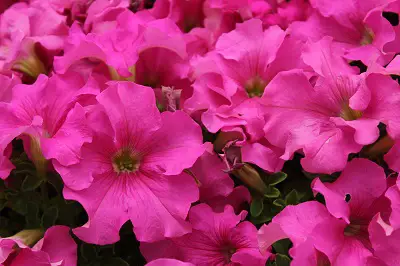
A sweet fragranced, gorgeous-looking, dwarf-sized flowering plant, petunia comes in a variety of colors and shapes. You can grow them in containers as well as lined on the edges or in hanging baskets for your patio. The color bubble gum pink can add so much to your garden aesthetics. These are very delicate flowers that are perennial in nature as they cannot tolerate cold weather.
Care Guide:
Regular watering is a must for petunias as they have a shallow root system. However, they do not like wet feet as that causes root rot. Just make sure that you water the soil and not the foliage as that may welcome pest infestation. The soil should be moist but well-drained. Petunias love basking in the sun. They will respond by multiple blooming when you give them ample sunlight. Fertilizing in summers is very important especially if you are growing them in containers. Adding slow-release granular formula or liquid fertile once a month is good for them.
Bloom Time:
Petunia simply hates winters. So plant them in spring when the risk of the last frost has ended. They will bloom in summers with full sun. These plants will grow in part shade but the blooming capability will decrease.
Make your garden lush green with these tips on how to fertilize your grass to make it grow faster.
2. Peonies
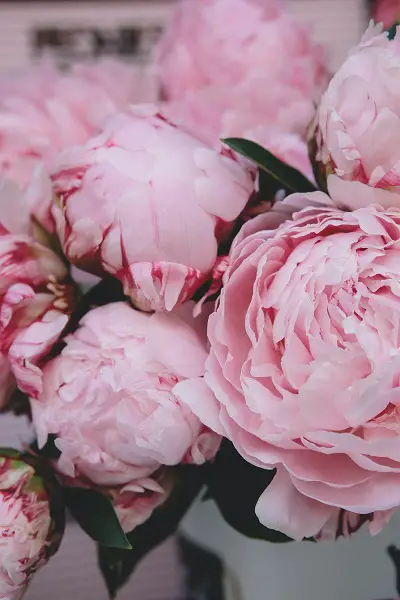
Looking for plants that will brighten up your garden? Look no further as peonies fit in the true definition of sweet fragrant and fluffy flowers that will stand out in the garden for every good reason. You can find them in every color except blue but the hues of pink are especially praiseworthy. Peonies have a huge variety and are primarily categorized as trees, bushes, and Itoh (a cross between the trees and bushes). Plant them in your garden and you won’t regret as they are known to have mood-boosting properties. The flowers go in dormancy in the winter chill.
Care Guide:
Peonies need full sun exposure for at least 8 hours, anything less than that will result in lesser flowering. They like well-drained and moist soil so water accordingly. One thing they like the most is nutrient-rich soil to grow. So don’t plant them near the plants that will take up their share of nutrients from the soil. Just protect the large-sized blooms from the gusts of winds.
Bloom Time:
Peonies usually bloom from late spring to early summer. But there are other varieties that bloom late to extend the blooming period. Just plant them in fall as the buds need colder temperatures.
3. Geranium
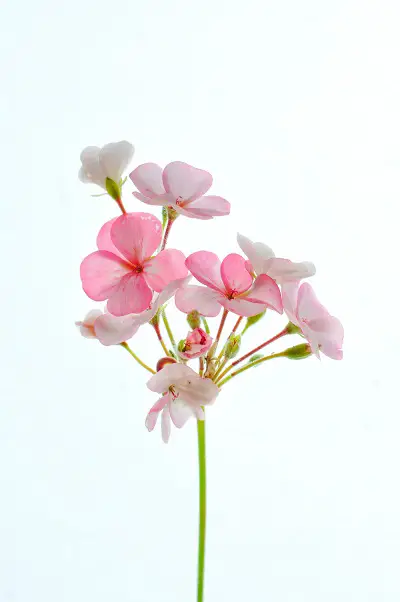
Geranium is an extremely easy-growing and rewarding flowering plant that can be a focal point of your garden and the pink-colored flowers will be the envy of your neighborhood. These are annuals that can be grown in hanging baskets, containers as well as flower beds. They are known to be excellent companion plants (that keep away) for your vegetable patch.
Care Guide:
These are sun-loving plants that hate too much fertilizing. If they are not satisfied, they will show their unhappiness by flowering less. Geranium definitely does not like wet clumpy soil. Keep the soil moist but well-drained to avoid root rot. Make sure the topsoil dries between watering, but when you do, give them ample water.
Bloom Time:
Do not plant them unless the last frost has finished as they are not winter-hardy. Make sure that your soil reaches a temperature of 60 degrees Fahrenheit. They have a long blooming time that starts in spring and ends in fall. They might also bloom in climates where there are no harsh winters.
Did you know you can grow plants in water instead of soil? Here’s a comprehensive list of indoor water plants and herbs that you can grow all year long.
4. Celosia
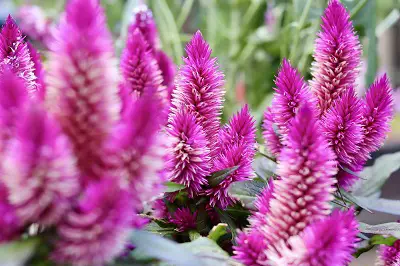
Enhance the appeal of your backyard garden by planting Celosia. From its vibrant colored flower selection, pink celosia stands out the most. Celosia is a tropical plant that loves warm and humid climatic conditions. Grow them in your yard and if provided with the right conditions, they can grow into quite tall plants.
Care Guide:
These flowering plants require fertilizer every two to three weeks once the flowers start blooming. You must give them as much sun exposure as possible. They are somewhat considered drought tolerant. Do not overwater them to avoid the threat of root rot. Water them only when the topsoil is dried out and reduce watering in winters.
Bloom Time:
These plants bloom from late summers and last till autumn. Plant them approximately 2 months before your average frost date.
5. Hibiscus
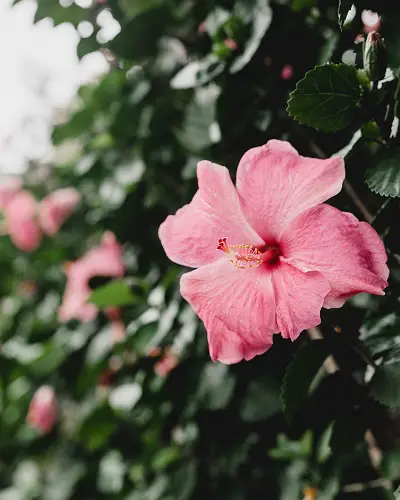
A fruity blended drink and a rich pink hibiscus flower in the hair, doesn’t that give you a true beachy vibe? That’s because these are the true definition of tropical plants that love warm weather and humid air. Commonly hibiscus plants are annuals but there are some winter hardy ones that act as perennials too. Hibiscus needs a little extra effort when it comes to taking care of them. You can grow them in your garden as well as in containers, though some people vouch for growing them in containers because you can move them around according to their needs.
Care Guide:
If your hibiscus is growing in containers then you need to water them daily otherwise you can skip a day in between. Watering them with warm water is a great tip for healthy blooms. Cut back on watering if the leaves are turning yellow. Prune them every spring (for perennial varieties). If you want a happy hibiscus, give them as much sunlight as you can. They do not like alkaline soil. Rich well-drained soil is what they like the most.
Bloom Time:
Perennial hibiscus usually blooms in midsummers and lasts till it ends. August is considered to be the most popular month for flowering.
6. Impatiens
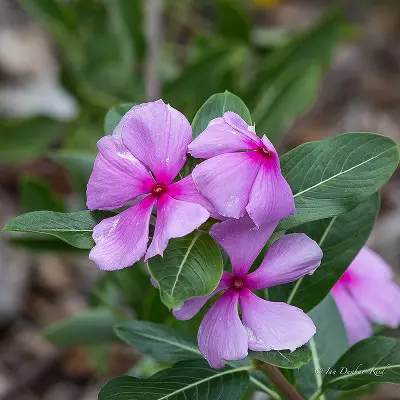
If you want to brighten up your gloomy yard, we suggest planting impatiens. They will instantly cheer up the whole yard with their bright pink-colored flowers (when they start flowering, of course). Impatiens are very tender perennial plants that come in a variety of colors. These are short plants that grow no more than a foot tall. They need to be protected from winds.
Did you know? These are also called touch me not as once touched, the ripe seed pots suddenly burst.
Care Guide:
Not your drought-tolerant plants, they need to be watered regularly while not water logging the roots. Do not expose them to much sun as the flowers are very delicate and shade loving. Too much sun will reduce the flowering of the plant. You should fertilize them moderately. Fertilizing after every two weeks is good for the ones growing in containers.
Bloom Time:
These are perennial plants that can be planted in April and will bloom in late May. These plants literally die in winters and come back from their own seeds in late spring.
Short of space to grow plants? Become a pro at vertical gardening with this carefully curated list of hanging flower plants that will brighten up your garden.
7. Dianthus
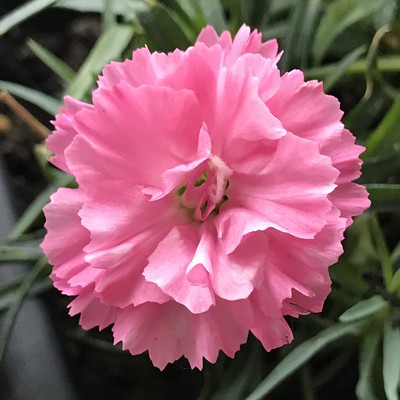
Dianthus grows in beautiful shades of pink while giving your yard a cottage yard look. These shades of pink include magenta and salmon pink as well. Not only will the color of these flowers make your garden aesthetically beautiful but the fragrance will also make it more appealing. They look great when planted in flower beds.
Care Guide:
Dianthus thrives best in a humid atmosphere. They can tolerate a lot of heat in places where there is ample rainfall. They bloom best in at least 6 hours of sun with well-drained moist soil. Do not mulch near your Dianthus. They can be grown as perennial, bi perennials, and annuals.
Bloom Time:
They bloom in early spring or summer and remain like that throughout the gardening season.
Whether you plan to plant them in containers or in flowers beds, there is always one pink flowering plant that will enchant you with its perfect color and beauty. Pick one and add that aura to your very own garden.


